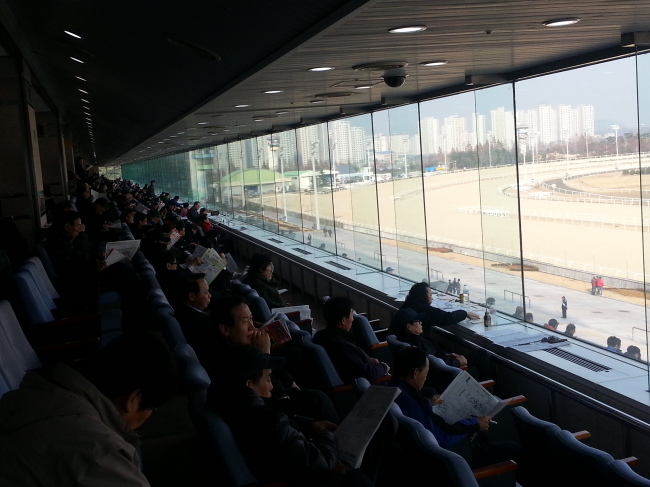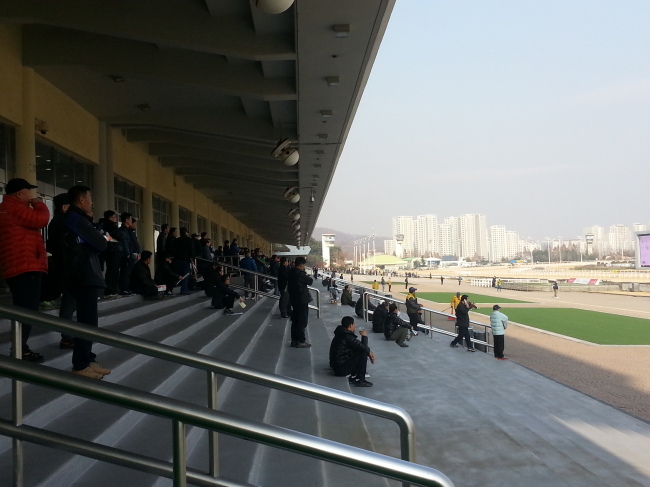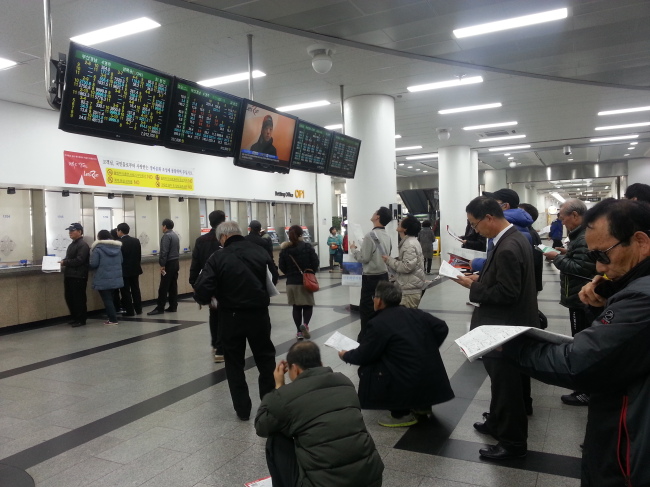Horse racing agency fails to shed stigma
Racecourse park has class structure of its own
By Kim Young-wonPublished : Nov. 25, 2014 - 21:20
The Korea Racing Authority, South Korea’s public agency to promote horse racing, has long been trying to change the negative public perceptions on the industry and to make horse race parks across the nation family-friendly places.
The scene at Seoul Racecourse Park in Gwacheon City, however, showed that these efforts have yet to bear any fruit.
“It will be next to impossible to improve the park’s environment,” said a former employee of KRA who described the park as nothing short of a gambling den.
When the races open, those who come to bet on the horses ― mostly men in their 50s or older ― are glued to the TV screens inside the two six-story grandstand buildings or to the big screens in the arena.
The scene at Seoul Racecourse Park in Gwacheon City, however, showed that these efforts have yet to bear any fruit.
“It will be next to impossible to improve the park’s environment,” said a former employee of KRA who described the park as nothing short of a gambling den.
When the races open, those who come to bet on the horses ― mostly men in their 50s or older ― are glued to the TV screens inside the two six-story grandstand buildings or to the big screens in the arena.


But the bigger problem is the huge gap that exists between the VIPs and those who come to bet with pocket money. The divide is such that some have compared the park to the bullet train featured in the movie “Snowpiercer” where the elites inhabit the front of the train while the underprivileged residents inhabit the tail.
The only difference in the racecourse park buildings ― one is called the Lucky Ville and the other Happy Ville ― is that the class system is formed vertically, not horizontally.
The VIPs including the horse owners can watch the races on the top of the buildings, enjoying premium services including customized catering services, while the underprivileged betters stay on the lower floors, eating hot dogs and other cheap snacks.
Once all the scheduled races come to a close at the end of the day, betting tickets, horse racing magazines and food wrappers are found scattered on the floors of the grandstand buildings amid a sense of dispair.

High addiction rates is another reason for the negative sentiment toward the horse racing industry. Recent research showed that the addiction rate among those betting on horseraces located further away from metropolitan areas stood at 80 percent. The rate for those betting at the arenas in Gwacheon, Busan and Jeju, stood at 43 percent, according to the data.
Due to the high addiction rates, the KRA’s plans to expand into more betting facilities across the nation has been met with much flak.
Recently, the KRA clashed with residents in Yongsan-gu in Seoul City where it is trying to launch a betting facility.
Siding with the opponents to the plan, Seoul mayor Park Won-soon criticized the public agency, saying that the plan to build the gambling place in a residential area is “inappropriate,“ adding that he would have “abolished the plans” if he had the authority to do so.
The KRA’s goal to reposition horse racing as a healthy, popular sport by transforming the racing parks into family-friendly venues for fun and leisure seems to be still a long way off.
By Kim Young-won (wone0102@heraldcorp.com)






![[Weekender] How DDP emerged as an icon of Seoul](http://res.heraldm.com/phpwas/restmb_idxmake.php?idx=644&simg=/content/image/2024/04/25/20240425050915_0.jpg&u=)



![[Music in drama] An ode to childhood trauma](http://res.heraldm.com/phpwas/restmb_idxmake.php?idx=644&simg=/content/image/2024/04/25/20240425050929_0.jpg&u=)







![[Herald Interview] Mistakes turn into blessings in street performance, director says](http://res.heraldm.com/phpwas/restmb_idxmake.php?idx=652&simg=/content/image/2024/04/28/20240428050150_0.jpg&u=20240428174656)
